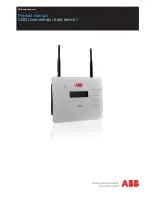
WSD12-EVTT
User Manual
CAPETTI ELETTRONICA s.r.l. - Strada Stratta, 57
10090 CASTIGLIONE TORINESE - TORINO - ITALY
VAT 04837130014 - Phone 011.981.98.11 - Fax 011.981.98.210
e-mail
WA0304E_WSD12-EVTT_User Manual_R05
V4.8
3.
Device pre-set and use mode.
a.
Wireless Mode:
No setup operation is needed. Typically, the system is configured from factory, so the device is already associated to the system
basestation
. The device is in
STANDBY
mode (
refer to
Picture 6 - Status table - Radio signal quality
) for which is necessary to start it
with the
TEST
command (
refer to
Otherwise, in case the device is in
FACTORY RESET
mode (
refer to
Picture 6 - Status table - Radio signal quality
), that means it's ready
for connecting to an existing system, in order to associate it, make reference to the
WineCap System - User Manual R30
software manual. Is necessary to use the "
" software on the PC connected to the
basestation
that will be
coupled with the device.
b.
USB Logger Mode:
For this operation mode, stand-alone
with data downloads through USB, the connection with the PC and the “
running on it is necessary in order to modify the device 's operation mode. The sampling interval must be set with the device in
"
STAND-ALONE
" (
refer to
7 - Stand-alone USB datalogger installation.
) mode and automatically, the device 's clock is aligned with the
PC's clock, in order to assure the temporal reference of the sample.
Sampling operations start may be selected disconnecting the USB cable or giving the proper command with the magnetic key.
(
Stand-alone USB datalogger installation.
). More details on device 's connection/disconnection through the USB cable are
available on the
WineCap System - User Manual R30
manual.
c.
On field transition from USB to Wireless datalogger:
This transition is practicable in field, during the sampling period, using the wireless network association command. When the
association is done, the
datalogger
becomes a wireless
datalogger
and, besides sending new measures to the
basestation
, starts
a download process towards the same
basestation
of the measures acquired during the stand-alone period (
refer to
Picture 3 - Device positioning

























